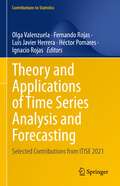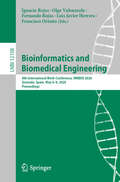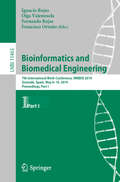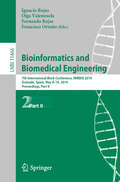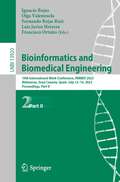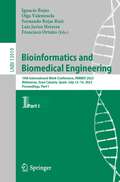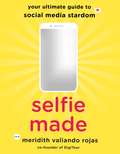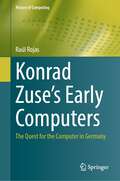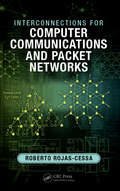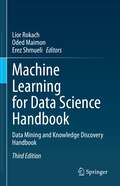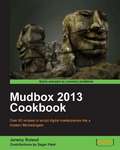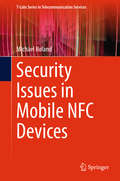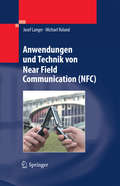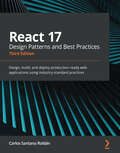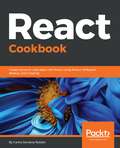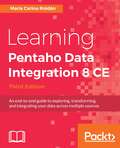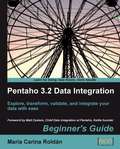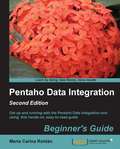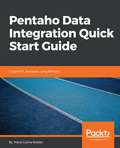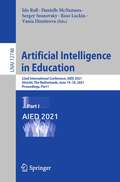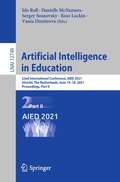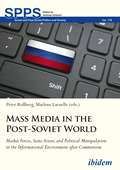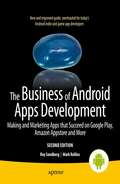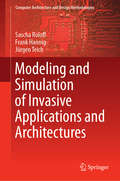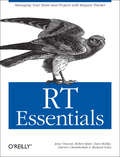- Table View
- List View
Theory and Applications of Time Series Analysis and Forecasting: Selected Contributions from ITISE 2021 (Contributions to Statistics)
by Ignacio Rojas Héctor Pomares Olga Valenzuela Fernando Rojas Luis Javier HerreraThis book presents a selection of peer-reviewed contributions on the latest developments in time series analysis and forecasting, presented at the 7th International Conference on Time Series and Forecasting, ITISE 2021, held in Gran Canaria, Spain, July 19-21, 2021. It is divided into four parts. The first part addresses general modern methods and theoretical aspects of time series analysis and forecasting, while the remaining three parts focus on forecasting methods in econometrics, time series forecasting and prediction, and numerous other real-world applications. Covering a broad range of topics, the book will give readers a modern perspective on the subject.The ITISE conference series provides a forum for scientists, engineers, educators and students to discuss the latest advances and implementations in the foundations, theory, models and applications of time series analysis and forecasting. It focuses on interdisciplinary research encompassing computer science, mathematics, statistics and econometrics.
Bioinformatics and Biomedical Engineering: 8th International Work-Conference, IWBBIO 2020, Granada, Spain, May 6–8, 2020, Proceedings (Lecture Notes in Computer Science #12108)
by Ignacio Rojas Olga Valenzuela Fernando Rojas Luis Javier Herrera Francisco OrtuñoThis volume constitutes the proceedings of the 8th International Work-Conference on IWBBIO 2020, held in Granada, Spain, in May 2020. The total of 73papers presented in the proceedings, was carefully reviewed and selected from 241 submissions. The papers are organized in topical sections as follows: Biomarker Identification; Biomedical Engineering; Biomedical Signal Analysis; Bio-Nanotechnology; Computational Approaches for Drug Design and Personalized Medicine; Computational Proteomics and Protein-Protein Interactions; Data Mining from UV/VIS/NIR Imaging and Spectrophotometry; E-Health Technology, Services and Applications; Evolving Towards Digital Twins in Healthcare (EDITH); High Performance in Bioinformatics; High-Throughput Genomics: Bioinformatic Tools and Medical Applications; Machine Learning in Bioinformatics; Medical Image Processing; Simulation and Visualization of Biological Systems.
Bioinformatics and Biomedical Engineering: 7th International Work-Conference, IWBBIO 2019, Granada, Spain, May 8-10, 2019, Proceedings, Part I (Lecture Notes in Computer Science #11465)
by Ignacio Rojas Olga Valenzuela Fernando Rojas Francisco OrtuñoThe two-volume set LNBI 11465 and LNBI 11466 constitutes the proceedings of the 7th International Work-Conference on Bioinformatics and Biomedical Engineering, IWBBIO 2019, held in Granada, Spain, in May 2019. The total of 97 papers presented in the proceedings, was carefully reviewed and selected from 301 submissions. The papers are organized in topical sections as follows: Part I: High-throughput genomics: bioinformatics tools and medical applications; omics data acquisition, processing, and analysis; bioinformatics approaches for analyzing cancer sequencing data; next generation sequencing and sequence analysis; structural bioinformatics and function; telemedicine for smart homes and remote monitoring; clustering and analysis of biological sequences with optimization algorithms; and computational approaches for drug repurposing and personalized medicine. Part II: Bioinformatics for healthcare and diseases; computational genomics/proteomics; computational systems for modelling biological processes; biomedical engineering; biomedical image analysis; and biomedicine and e-health.
Bioinformatics and Biomedical Engineering: 7th International Work-Conference, IWBBIO 2019, Granada, Spain, May 8-10, 2019, Proceedings, Part II (Lecture Notes in Computer Science #11466)
by Ignacio Rojas Olga Valenzuela Fernando Rojas Francisco OrtuñoThe two-volume set LNBI 11465 and LNBI 11466 constitutes the proceedings of the 7th International Work-Conference on Bioinformatics and Biomedical Engineering, IWBBIO 2019, held in Granada, Spain, in May 2019. The total of 97 papers presented in the proceedings, was carefully reviewed and selected from 301 submissions. The papers are organized in topical sections as follows: Part I: High-throughput genomics: bioinformatics tools and medical applications; omics data acquisition, processing, and analysis; bioinformatics approaches for analyzing cancer sequencing data; next generation sequencing and sequence analysis; structural bioinformatics and function; telemedicine for smart homes and remote monitoring; clustering and analysis of biological sequences with optimization algorithms; and computational approaches for drug repurposing and personalized medicine. Part II: Bioinformatics for healthcare and diseases; computational genomics/proteomics; computational systems for modelling biological processes; biomedical engineering; biomedical image analysis; and biomedicine and e-health.
Bioinformatics and Biomedical Engineering: 10th International Work-Conference, IWBBIO 2023, Meloneras, Gran Canaria, Spain, July 12–14, 2023, Proceedings, Part II (Lecture Notes in Computer Science #13920)
by Ignacio Rojas Olga Valenzuela Fernando Rojas Ruiz Luis Javier Herrera Francisco OrtuñoThis volume constitutes the proceedings of the 10th International Work-Conference on IWBBIO 2023, held in Meloneras, Gran Canaria, Spain, during July 12-14, 2022. The total of 79 papers presented in the proceedings, was carefully reviewed and selected from 209 submissions. The papers cove the latest ideas and realizations in the foundations, theory, models, and applications for interdisciplinary and multidisciplinary research encompassing disciplines of computer science, mathematics, statistics, biology, bioinformatics, and biomedicine.
Bioinformatics and Biomedical Engineering: 10th International Work-Conference, IWBBIO 2023, Meloneras, Gran Canaria, Spain, July 12–14, 2023, Proceedings, Part I (Lecture Notes in Computer Science #13919)
by Ignacio Rojas Olga Valenzuela Fernando Rojas Ruiz Luis Javier Herrera Francisco OrtuñoThis volume constitutes the proceedings of the 10th International Work-Conference on IWBBIO 2023, held in Meloneras, Gran Canaria, Spain, during July 12-14, 2022. The total of 79 papers presented in the proceedings, was carefully reviewed and selected from 209 submissions. The papers cove the latest ideas and realizations in the foundations, theory, models, and applications for interdisciplinary and multidisciplinary research encompassing disciplines of computer science, mathematics, statistics, biology, bioinformatics, and biomedicine.
Selfie Made: Your Ultimate Guide to Social Media Stardom
by Meridith Valiando RojasHOW DO I MAKE IT BIG ON SOCIAL MEDIA? WHAT IS MY STORY—AND WHO IS MY AUDIENCE? WHAT CONTENT SHOULD I POST TO ACHIEVE #SUCCESS? HOW DO I GO VIRAL…OR HOW LONG WILL IT TAKE ME TO GET NOTICED?Selfie Made is a one-of-a-kind guide to creating a digital identity, finding an audience, and building a powerful brand—your own!—on the Internet. Whether you want to be in front of or behind the camera, produce click-worthy content or start your own business, this book is the place to begin. Written by Meridith Valiando Rojas, the hugely successful (and super friendly IRL) founder of DigiTour who has worked with every major star from YouTube to Musical.ly, this collection of personal anecdotes and professional advice, tricks of the trade and behind-the-screen secrets, will give you everything you need for your social media toolkit.Here, you’ll get to know the true stories behind some of today’s most successful multimedia stars and influencers, including:Max And Harvey - Blake Gray - Danielle CohnBryce Xavier - Lauren Godwin - Nathan TriskaTrevor Moran - Messy Monday - Simon Britton…and others who learned the ropes, beat the odds, and took social media by storm. And so can you!
Konrad Zuse's Early Computers: The Quest for the Computer in Germany (History of Computing)
by Raúl RojasThis book describes the historical development of the architectures of the first computers built by the German inventor Konrad Zuse in Berlin between 1936 and 1945. Zuse's machines are historically important because they anticipated many features of modern computers. Specifically, these include the separation of processor and memory, the ability to compute with floating-point numbers, a hardware architecture based on microprogramming of the instruction set, and a layered design with a high-level programming language on top. In fact, Zuse's early computers are closer to modern computers than the Harvard Mark I or ENIAC, two other contenders for the title of "world's first computer." The theoretical program first conceived by Zuse in 1936/37 was fulfilled with a series of machines built before and during World War II: the Z1, Z2, Z3, and Z4. Separate chapters deal with the architecture of each computer, culminating in the description of Plankalkül, the first proposal for a high-level programming language. Students of the sciences and practitioners of computer science should have no trouble following the material. The concise introductory summary sets the reader on the historical path to retrace this remarkable intellectual adventure.
Interconnections for Computer Communications and Packet Networks
by Roberto Rojas-CessaThis book introduces different interconnection networks applied to different systems. Interconnection networks are used to communicate processing units in a multi-processor system, routers in communication networks, and servers in data centers. Queuing techniques are applied to interconnection networks to support a higher utilization of resources. There are different queuing strategies, and these determine not only the performance of the interconnection network, but also the set of requirements to make them work effectively and their cost. Routing algorithms are used to find routes to destinations and directions in what information travels. Additional properties, such as avoiding deadlocks and congestion, are sought. Effective routing algorithms need to be paired up with these networks. The book will introduce the most relevant interconnection networks, queuing strategies, and routing algorithm. It discusses their properties and how these leverage the performance of the whole interconnection system. In addition, the book covers additional topics for memory management and congestion avoidance, used to extract higher performance from the interconnection network.
Machine Learning for Data Science Handbook: Data Mining and Knowledge Discovery Handbook
by Lior Rokach Oded Maimon Erez ShmueliThis book organizes key concepts, theories, standards, methodologies, trends, challenges and applications of data mining and knowledge discovery in databases. It first surveys, then provides comprehensive yet concise algorithmic descriptions of methods, including classic methods plus the extensions and novel methods developed recently. It also gives in-depth descriptions of data mining applications in various interdisciplinary industries.
Mudbox 2013 Cookbook
by Jeremy RolandWritten in cookbook style, this book offers many recipes to learn digital sculpting with Mudbox. Each recipe contains step-by-step instructions followed by analysis of what was done in each task and other useful information. The book is designed so that you can read it chapter by chapter, or you can look at the list of recipes and refer to them in no particular order,This book is for 3D modelers and texture artists who are, or would like to be, working in the games, movies, product design, television, medical imaging, or advertising industries. By learning the techniques in this book you will be able to create "next gen" assets for the game industry, create realistic creatures and sets for movies, and add the fine details needed for medical images and animations. Whether you are an Environment Artist or a Character Artist there is much to learn from this book.
Security Issues in Mobile NFC Devices
by Michael RolandThis work provides an assessment of the current state of near field communication (NFC) security, it reports on new attack scenarios, and offers concepts and solutions to overcome any unresolved issues. The work describes application-specific security aspects of NFC based on exemplary use-case scenarios and uses these to focus on the interaction with NFC tags and on card emulation. The current security architectures of NFC-enabled cellular phones are evaluated with regard to the identified security aspects.
Anwendungen und Technik von Near Field Communication (NFC)
by Michael Roland Josef LangerNFC ist eine systematische Weiterentwicklung von kontaktloser Smartcard- und Reader-Technologie. Das Buch "Anwendungen und Technik von NFC" ist das Standardwerk zur NFC-Technologie. Es bietet einen umfassenden Überblick über Grundlagen, Technik und Anwendungszenarien von NFC. Für Praxis und Ausbildung kann es sowohl als Einführung sowie als Grundlagen- und Nachschlagewerk dienen. Die Autoren stellen anhand der Grundlagen und der Technik die NFC-Technologie und die klassische RFID-Technologie einander gegenüber. Es werden der aktuelle Stand der Normung, die weiterführenden Spezifikationen und die Protokolle ausführlich anhand von zahlreichen Abbildungen erklärt. Besonderes Augenmerk wird auf die Integration von NFC in Mobiltelefone gelegt. Zahlreiche beispielhafte Anwendungen (z.B. Smart Poster, Zahlungsverkehr, Zutritt) geben einen praxisnahen Einblick in die Umsetzung der Technologie und das NFC-Ökosystem mit seiner Vielzahl von Anwendungsmöglichkeiten.
React 17 Design Patterns and Best Practices: Design, build, and deploy production-ready web applications using industry-standard practices, 3rd Edition
by Carlos Santana RoldanBuild modular React web apps that are scalable, maintainable, and powerful using design patterns and insightful best practicesKey FeaturesGet up to speed with design patterns in React such as render props and controlled and uncontrolled inputsBecome well-versed with React Hooks in this updated third editionWork through examples that can be used to create reusable code and extensible designsBook DescriptionReact is an open-source, adaptable JavaScript library for building complex user interfaces (UIs) from small, detached bits called components. This book will help you to use React effectively to make your applications more flexible, easier to maintain, and improve their performance, while giving your workflow a huge boost by improving speed without affecting quality. You'll start by understanding the internals of React, before gradually moving on to writing maintainable and clean code. The chapters that follow will show you how to build components that are reusable across the application, structure applications, and create forms that actually work. Later, you will build on your knowledge by exploring how to style React components and optimize them to make applications faster and more responsive. Finally, you'll write tests effectively and learn how to contribute to React and its ecosystem. By the end of this book, you'll be able to avoid the process of trial and error and developmental headaches, and instead, have the skills you need to efficiently build and deploy real-world React web applications.What you will learnGet to grips with the techniques of styling and optimizing React componentsCreate components using the new React HooksGet to grips with the new React Suspense technique and using GraphQL in your projectsUse server-side rendering to make applications load fasterWrite a comprehensive set of tests to create robust and maintainable codeBuild high-performing applications by optimizing componentsWho this book is forThis book is for web developers who want to increase their understanding of React and apply it to real-life app development. Intermediate-level experience with React and JavaScript is assumed.
React Cookbook: Create dynamic web apps with React using Redux, Webpack, Node.js, and GraphQL
by Carlos Santana RoldanOver 66 hands-on recipes that cover UI development, animations, component architecture, routing, databases, testing, and debugging with React Key FeaturesUse essential hacks and simple techniques to solve React application development challengesCreate native mobile applications for iOS and Android using React NativeLearn to write robust tests for your applications using Jest and EnzymeBook DescriptionToday's web demands efficient real-time applications and scalability. If you want to learn to build fast, efficient, and high-performing applications using React 16, this is the book for you. We plunge directly into the heart of all the most important React concepts for you to conquer. Along the way, you’ll learn how to work with the latest ECMAScript features.You'll see the fundamentals of Redux and find out how to implement animations. Then, you’ll learn how to create APIs with Node, Firebase, and GraphQL, and improve the performance of our application with Webpack 4.x. You'll find recipes on implementing server-side rendering, adding unit tests, and debugging. We also cover best practices to deploy a React application to production. Finally, you’ll learn how to create native mobile applications for iOS and Android using React Native.By the end of the book, you'll be saved from a lot of trial and error and developmental headaches, and you’ll be on the road to becoming a React expert.What you will learnGain the ability to wield complex topics such as Webpack and server-side renderingImplement an API using Node.js, Firebase, and GraphQLLearn to maximize the performance of React applicationsCreate a mobile application using React NativeDeploy a React application on Digital OceanGet to know the best practices when organizing and testing a large React applicationWho this book is forIf you’re a JavaScript developer who wants to build fast, efficient, scalable solutions, then you’re in the right place. Knowledge of React will be an advantage but is not required. Experienced users of React will be able to improve their skills.
Learning Pentaho Data Integration 8 CE - Third Edition
by Maria Carina RoldanGet up and running with the Pentaho Data Integration tool using this hands-on, easy-to-read guide About This Book • Manipulate your data by exploring, transforming, validating, and integrating it using Pentaho Data Integration 8 CE • A comprehensive guide exploring the features of Pentaho Data Integration 8 CE • Connect to any database engine, explore the databases, and perform all kind of operations on relational databases Who This Book Is For This book is a must-have for software developers, business intelligence analysts, IT students, or anyone involved or interested in developing ETL solutions. If you plan on using Pentaho Data Integration for doing any data manipulation task, this book will help you as well. This book is also a good starting point for data warehouse designers, architects, or anyone who is responsible for data warehouse projects and needs to load data into them. What You Will Learn • Explore the features and capabilities of Pentaho Data Integration 8 Community Edition • Install and get started with PDI • Learn the ins and outs of Spoon, the graphical designer tool • Learn to get data from all kind of data sources, such as plain files, Excel spreadsheets, databases, and XML files • Use Pentaho Data Integration to perform CRUD (create, read, update, and delete) operations on relationaldatabases • Populate a data mart with Pentaho Data Integration • Use Pentaho Data Integration to organize files and folders, run daily processes, deal with errors, and more In Detail Pentaho Data Integration(PDI) is an intuitive and graphical environment packed with drag-and-drop design and powerful Extract-Tranform-Load (ETL) capabilities. This book shows and explains the new interactive features of Spoon, the revamped look and feel, and the newest features of the tool including transformations and jobs Executors and the invaluable Metadata Injection capability. We begin with the installation of PDI software and then move on to cover all the key PDI concepts. Each of the chapter introduces new features, enabling you to gradually get practicing with the tool. First, you will learn to do all kind of data manipulation and work with simple plain files. Then, the book teaches you how you can work with relational databases inside PDI. Moreover, you will be given a primer on data warehouse concepts and you will learn how to load data in a data warehouse. During the course of this book, you will be familiarized with its intuitive, graphical and drag-and-drop design environment. By the end of this book, you will learn everything you need to know in order to meet your data manipulation requirements. Besides, your will be given best practices and advises for designing and deploying your projects. Style and approach Step by step guide filled with practical, real world scenarios and examples.
Pentaho 3.2 Data Integration: Beginner's Guide
by Maria Carina RoldanAs part of Packt's Beginner's Guide, this book focuses on teaching by example. The book walks you through every aspect of PDI, giving step-by-step instructions in a friendly style, allowing you to learn in front of your computer, playing with the tool. The extensive use of drawings and screenshots make the process of learning PDI easy. Throughout the book numerous tips and helpful hints are provided that you will not find anywhere else. The book provides short, practical examples and also builds from scratch a small datamart intended to reinforce the learned concepts and to teach you the basics of data warehousing. This book is for software developers, database administrators, IT students, and everyone involved or interested in developing ETL solutions, or, more generally, doing any kind of data manipulation. If you have never used PDI before, this will be a perfect book to start with. You will find this book is a good starting point if you are a database administrator, data warehouse designer, architect, or any person who is responsible for data warehouse projects and need to load data into them. You don't need to have any prior data warehouse or database experience to read this book. Fundamental database and data warehouse technical terms and concepts are explained in easy-to-understand language.
Pentaho Data Integration Beginner's Guide, Second Edition
by María Carina RoldanThis book focuses on teaching you by example. The book walks you through every aspect of Pentaho Data Integration, giving systematic instructions in a friendly style, allowing you to learn in front of your computer, playing with the tool. The extensive use of drawings and screenshots make the process of learning Pentaho Data Integration easy. Throughout the book, numerous tips and helpful hints are provided that you will not find anywhere else.This book is a must-have for software developers, database administrators, IT students, and everyone involved or interested in developing ETL solutions, or, more generally, doing any kind of data manipulation. Those who have never used Pentaho Data Integration will benefit most from the book, but those who have, they will also find it useful.This book is also a good starting point for database administrators, data warehouse designers, architects, or anyone who is responsible for data warehouse projects and needs to load data into them.
Pentaho Data Integration Quick Start Guide: Create ETL processes using Pentaho
by María Carina RoldánGet productive quickly with Pentaho Data IntegrationKey FeaturesTake away the pain of starting with a complex and powerful systemSimplify your data transformation and integration workExplore, transform, and validate your data with Pentaho Data IntegrationBook DescriptionPentaho Data Integration(PDI) is an intuitive and graphical environment packed with drag and drop design and powerful Extract-Transform-Load (ETL) capabilities. Given its power and flexibility, initial attempts to use the Pentaho Data Integration tool can be difficult or confusing. This book is the ideal solution.This book reduces your learning curve with PDI. It provides the guidance needed to make you productive, covering the main features of Pentaho Data Integration. It demonstrates the interactive features of the graphical designer, and takes you through the main ETL capabilities that the tool offers.By the end of the book, you will be able to use PDI for extracting, transforming, and loading the types of data you encounter on a daily basis.What you will learnDesign, preview and run transformations in SpoonRun transformations using the Pan utilityUnderstand how to obtain data from different types of files Connect to a database and explore it using the database explorerUnderstand how to transform data in a variety of waysUnderstand how to insert data into database tablesDesign and run jobs for sequencing tasks and sending emailsCombine the execution of jobs and transformationsWho this book is forThis book is for software developers, business intelligence analysts, and others involved or interested in developing ETL solutions, or more generally, doing any kind of data manipulation.
Artificial Intelligence in Education: 22nd International Conference, AIED 2021, Utrecht, The Netherlands, June 14–18, 2021, Proceedings, Part I (Lecture Notes in Computer Science #12748)
by Ido Roll Danielle McNamara Sergey Sosnovsky Rose Luckin Vania DimitrovaThis two-volume set LNAI 12748 and 12749 constitutes the refereed proceedings of the 22nd International Conference on Artificial Intelligence in Education, AIED 2021, held in Utrecht, The Netherlands, in June 2021.*The 40 full papers presented together with 76 short papers, 2 panels papers, 4 industry papers, 4 doctoral consortium, and 6 workshop papers were carefully reviewed and selected from 209 submissions. The conference provides opportunities for the cross-fertilization of approaches, techniques and ideas from the many fields that comprise AIED, including computer science, cognitive and learning sciences, education, game design, psychology, sociology, linguistics as well as many domain-specific areas.*The conference was held virtually due to the COVID-19 pandemic.
Artificial Intelligence in Education: 22nd International Conference, AIED 2021, Utrecht, The Netherlands, June 14–18, 2021, Proceedings, Part II (Lecture Notes in Computer Science #12749)
by Ido Roll Danielle McNamara Sergey Sosnovsky Rose Luckin Vania DimitrovaThis two-volume set LNAI 12748 and 12749 constitutes the refereed proceedings of the 22nd International Conference on Artificial Intelligence in Education, AIED 2021, held in Utrecht, The Netherlands, in June 2021.*The 40 full papers presented together with 76 short papers, 2 panels papers, 4 industry papers, 4 doctoral consortium, and 6 workshop papers were carefully reviewed and selected from 209 submissions. The conference provides opportunities for the cross-fertilization of approaches, techniques and ideas from the many fields that comprise AIED, including computer science, cognitive and learning sciences, education, game design, psychology, sociology, linguistics as well as many domain-specific areas.*The conference was held virtually due to the COVID-19 pandemic.
Mass Media in the Post-Soviet World: Market Forces, State Actors, and Political Manipulation in the Informational Environment after Communism (Soviet and Post-Soviet Politics and Society #178)
by Peter Rollberg Marlene LaruelleThis collection covers the major trends of the media environment of the post-Communist world and their recent development, with special focus on Russia and the post-Soviet space. The term "media environment" covers not just traditional print and electronic media, but new media as well, and ranges from the political to entertainment and various artistic spheres. What role do market forces play in the process of media democratization, and how do state structures regulate, suppress, or use capitalism toward their own gain? What degree of informational pluralism has been achieved in the newly independent republics? What are the prospects for transparency and the participation of civil society in Russian and Eurasian media? To what degree do trends in post-Communist media reflect global trends? Is there a worldwide convergence with regard to both media formats and political messaging?Western observers usually pay their keenest attention to the role of media in Russia and Eurasia during national elections. While this is a valid focus, the present volume, with contributions by Luca Anceschi, Jonathan Becker, Lee B. Becker, Michael Cecire, Marta Dyczok, Nicola Ying Fry, Navbahor Imamova, Azamat Junisbai, Barbara Junisbai, Kornely Kakachia, Maria Lipman, Oleg Manaev, Marintha Miles, Olena Nikolayenko, Sarah Oates, Tamara Pataraia, Elisabeth Schimpfossl, Abdulfattoh Shafiev, Jack Snyder, Tudor Vlad, and Ilya Yablokov, aims at understanding the deeper overall media philosophies that characterize post-Soviet media systems and environments, and the type of identity formation that they are promoting.
The Business of Android Apps Development: Making and Marketing Apps that Succeed on Google Play, Amazon Appstore and More
by Mark Rollins Roy SandbergThe growing but still evolving success of the Android platform has ushered in a second mobile technology "gold rush" for app developers. Google Play and Amazon Appstore for Android apps has become the second go-to apps eco for today's app developers. While not yet as large in terms of number of apps as iTunes, Google Play and Amazon Appstore have so many apps that it has become increasingly difficult for new apps to stand out in the crowd. Achieving consumer awareness and sales longevity for your Android app requires a lot of organization and some strategic planning. Written for today's Android apps developer or apps development shop, this new and improved book from Apress, The Business of Android Apps Development, Second Edition, tells you today's story on how to make money on Android apps. This book shows you how to take your app from idea to design to development to distribution and marketing your app on Google Play or Amazon Appstore. This book takes you step-by-step through cost-effective marketing, public relations and sales techniques that have proven successful for professional Android app creators and indie shops-perfect for independent developers on shoestring budgets. It even shows you how to get interest from venture capitalists and how they view a successful app vs. the majority of so-so to unsuccessful apps in Android. No prior business knowledge is required. This is the book you wish you had read before you launched your first app!
Modeling and Simulation of Invasive Applications and Architectures (Computer Architecture and Design Methodologies)
by Sascha Roloff Frank Hannig Jürgen TeichThis book covers two main topics: First, novel fast and flexible simulation techniques for modern heterogeneous NoC-based multi-core architectures. These are implemented in the full-system simulator called InvadeSIM and designed to study the dynamic behavior of hundreds of parallel application programs running on such architectures while competing for resources. Second, a novel actor-oriented programming library called ActorX10, which allows to formally model parallel streaming applications by actor graphs and to analyze predictable execution behavior as part of so-called hybrid mapping approaches, which are used to guarantee real-time requirements of such applications at design time independent from dynamic workloads by a combination of static analysis and dynamic embedding.
RT Essentials: Managing Your Team and Projects with Request Tracker
by Dave Rolsky Darren Chamberlain Richard Foley Robert Spier Jesse VincentIn a typical organization, there's always plenty that to do such as: pay vendors, invoice customers, answer customer inquiries, and fix bugs in hardware or software. You need to know who wants what and keep track of what is left to do. This is where a ticketing system comes in. A ticketing system allows you to check the status of various tasks: when they were requested, who requested them and why, when they were completed, and more. RT is a high-level, open source ticketing system efficiently enabling a group of people to manage tasks, issues, and requests submitted by a community of users. RT Essentials, co-written by one of the RT's original core developers, Jesse Vincent, starts off with a quick background lesson about ticketing systems and then shows you how to install and configure RT. This comprehensive guide explains how to perform day-to-day tasks to turn your RT server into a highly useful tracking tool. One way it does this is by examining how a company could use RT to manage its internal processes. Advanced chapters focus on developing add-on tools and utilities using Perl and Mason. There's also chapter filled with suggested uses for RT inside your organization. No matter what kind of data your organization tracks--from sales inquiries to security incidents or anything in between--RT Essentials helps you use RT to provide order when you need it most.
